To succeed as an SEO analyst, you must be able to utilize data in a way that gives you a clear direction on where to focus your efforts for maximum impact.
You have access to a ton of data – but how to best make use of it all to drive measurable results that directly impact revenue?
In this article, you’ll find seven essential areas of focus you’ll need to succeed as an SEO analyst, with step-by-step instruction on the reports you need to produce these insights.
Beginners will find this particularly useful, although even a seasoned vet may learn a new thing or two!
1. Focus On Striking Distance Keywords
Within Google Search Console, you can access your striking distance keywords.
What Are Striking Distance Keywords?
Striking distance keywords are those near page one results (top ten) or currently ranking on the first page but are still not within the top five positions.
So why are they important?
The value of striking distance keywords is that you are already ranking in search results and will little effort, could achieve a top ranking.
If you update content that is currently ranking and build more high-quality DA backlinks, for example, you could push your keywords to the top of the SERPs.
How To Find Striking Distance Keywords
First, log in to Google Search Console.
Once logged in, select performance on the left-hand side, then select impressions and average position.
Deselect every other option. You want to focus on impressions and average position.
 Screenshot from Google Search Console, January 2022
Screenshot from Google Search Console, January 2022Once you select these two options, scroll down and click impressions to adjust the data to show the highest impression count for search queries listed to the right.
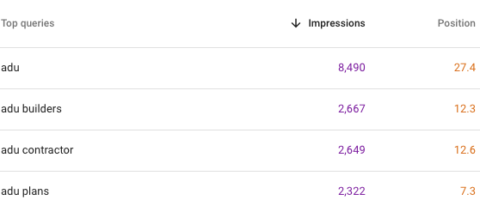 Screenshot from Google Search Console, January 2022
Screenshot from Google Search Console, January 2022The goal of this data analysis is twofold.
First, you are trying to uncover what keywords have the highest visibility count (impressions) within Google search results.
Secondly, find the keywords you are currently ranking for in search results that are not in the desired positions you would like.
The keyword “ADU plans” would be ideal since thousands of impressions have occurred and currently, it is only in the seventh position.
The average monthly search volume for this specific keyword is nineteen hundred per month.
Suppose the keyword was to achieve position one?
 Screenshot from Ahrefs, January 2022
Screenshot from Ahrefs, January 2022What To Expect From Focusing On Striking Distance Keywords
Once you achieve position one ranking, you’re in the territory of an average 28.5% CTR (click-through rate), which means for the example keyword “ADU plans” you could potentially produce 542 clicks per month.
The potential number of clicks for your striking distance keyword target will vary, of course.
But this is a good way to evaluate where you should focus your efforts and which striking distance keywords are highest priority.
The Profitability Of Focusing On Striking Distance Keywords
The cost to build an ADU ranges from two hundred to two hundred and fifty dollars per square foot.
ADU sizes range from six hundred square feet to twelve hundred square feet, which would equate to one hundred and twenty thousand dollars to three hundred thousand dollars.
It is safe to assume the selected striking distance keyword could potentially yield great profits.
As an SEO analyst, you must always consider the profitability of your keyword targets.
Ranking for keywords is great but ranking for profitable keywords is better.
What To Do Next
Dive into your striking distance data and prioritize identifying the high-value, low competition, and high impression keywords in the SERPs to drive results from your data.
You will be surprised what gold awaits you in Google Search Console.
2. Harvest User Interaction Data
One of the most important skills an SEO analyst can develop is your ability to think outside the box.
And you need data to drive those creative insights.
It’s important that you implement tracking that can harvest data to inform your SEO efforts – don’t just rely on the data given to you by default within Google Analytics or Google Search Console.
The Problem With Google Analytics
Google Analytics does not present, by default, many keywords you can use to help your SEO efforts. Instead, you are not provided with keywords for a large percentage of your data.
What’s an SEO analyst to do? Think outside the box and leverage the user engagement on your site to harvest your own keyword data.
Navigate to Google Tag Manager and set up internal and external click events. The goal of setting up click events is yet again twofold:
- First, compile keyword data that you can create content to drive more traffic.
- Second, and more importantly, convert visitors to sales from analyzing keywords that have proven to drive conversions.
Once you have configured GTM to trigger click events, you will have invaluable data.
You will be able to see which internal keywords mentioned within your posts produced a conversion action that you can add to your list of keywords to expand on.
External click events won’t be able to show you conversion data, but you will be able to see trending topics users have clicked on that you can utilize to build out keywords you should target.
3. Segment Conversions By Hour Of The Day
On Wall Street, the old saying is “the trend is your friend.”
By utilizing the conversions and traffic by hour report, you can easily spot trends when you export data from Google Analytics into Excel.
 Screenshot from Microsoft Excel, January 2022
Screenshot from Microsoft Excel, January 2022When using this report, you can filter out data that will lead to a false positive.
For instance, if you are an ecommerce store that sends an automated email campaign at 5 p.m. on Fridays, it will be no surprise when you see a spike in transactions during this time and day of the week.
The goal is to identify data that is not common knowledge to your organization. To create the conversion heatmap report, follow the directions below.
Step 1
Create a Flat Table custom report in Google Analytics. Select Day of Week Name, Hour, and select default channel grouping to your dimensions so you can filter by traffic sources, choose sessions and transactions for your metrics.
 Screenshot from Google Analytics, January 2022
Screenshot from Google Analytics, January 2022Step 2
Increase the data rows within Google Analytics before exporting to Excel.
 Screenshot from Google Analytics, January 2022
Screenshot from Google Analytics, January 2022Step 3
Export data into Excel, set up a pivot table to display rows and columns for the day of week and hour.
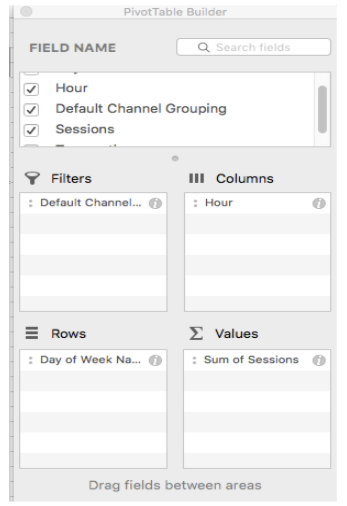 Screenshot from Microsoft Excel, January 2022
Screenshot from Microsoft Excel, January 2022Step 4
Apply conditional formatting to create a heatmap.
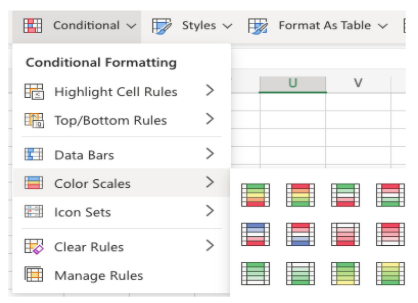 Screenshot from Microsoft Excel, January 2022
Screenshot from Microsoft Excel, January 2022While creating a heatmap from Google Analytics data is valuable, Google Analytics will not display a fully interactive heatmap.
Therefore, I recommend using third-party heatmap software to gather browser-based user interactions.
4. Analyze Branded vs. Non-branded Traffic
One of the most underestimated ways to create less work for yourself as an SEO analyst is to utilize Google Data Studio.
Google Data Studio can automate your reporting so you can spot trends quickly and efficiently.
In addition, Google Data Studio has several templates that you can plug and play.
One of the most valuable reports you can download as a template to configure to your UA property is the branded vs. non-branded report.
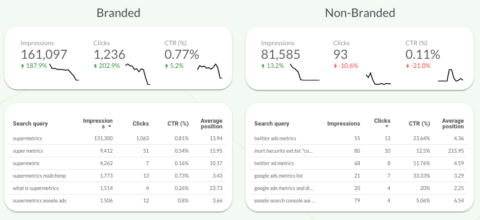 Screenshot from Google Sheets, January 2022
Screenshot from Google Sheets, January 2022Google Search Console does not allow you to quickly break down branded vs. non-branded traffic, which makes this report useful to spot trends.
Non-branded keywords may drive volume, but branded keywords provide search algorithms insight into what your brand stands for which increases your brand visibility and builds authority.
Google loves branded keywords. Former Google CEO Eric Schmidt stated,
“Brands are how you sort out the cesspool.”
As this statement comes from the former head of Google, you can rest assured it is a smart move to integrate non-branded vs. branded traffic into your SEO analysis.
5. Conduct A Content Gap Analysis
There are some genuinely great tools out there to reduce your workload as an SEO analyst significantly.
One of those magnificent tools is the content gap analysis tool by Ahrefs. This tool enables you to break down keyword opportunities that your competitors are not currently leveraging.
To conduct a top-level content gap analysis, enter a few competitors within Ahrefs.
 Screenshot from Ahrefs, January 2022
Screenshot from Ahrefs, January 2022Once you have entered competitors within the tool, click “show keywords.”
Once clicked, the report will generate keywords you are not ranking for that your competitors are ranking for currently.
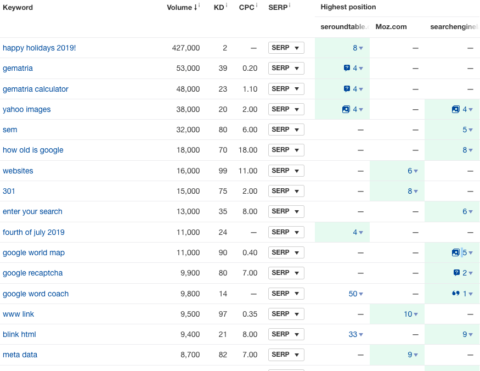 Screenshot from Ahrefs, January 2022
Screenshot from Ahrefs, January 2022Once you have that list of keywords your competitors are ranking for, you can quickly fill the gaps.
6. Use Behavioral Sequencing
Have you ever wondered how impactful a particular page was on your site at assisting a transaction?
Perhaps a blog post? Maybe a whitepaper?
By using the behavioral sequence report, you can better understand what can convert visitors to sales.
As an SEO analyst, you can expand your keyword focus for content that has assisted conversion.
To create this report, follow the steps below:
- Copy the folder path of a page you would like to analyze
- Click + Add Segment.
- Click New Segment.
- Navigate to Sequences.
- Under step one, select Landing page and paste the folder path you copied into the blank box to the right-hand side.
- Click Add Step.
- Under step two, select Transactions.
- Select per session or per hit (your choice)
- Select the greater than symbol “>”
- Enter zero into the blank box to the right-hand side.
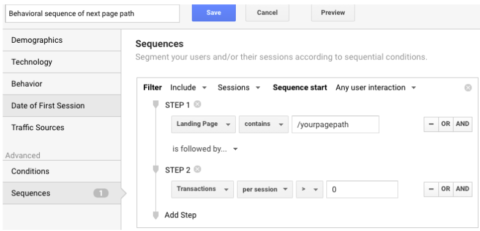 Screenshot from Google Analytics, January 2022
Screenshot from Google Analytics, January 2022 By looking at this report, you can drill down into any specific page to understand what drove direct transactions – no more guessing about the impact of your content creation efforts.
7. Leverage Predictive Search
One of the most helpful SEO tools is the predictive keywords generated from a Google search.
 Screenshot from search for [how to con], Google, January 2022
Screenshot from search for [how to con], Google, January 2022When conducting keyword research, leverage the predictive text suggestions. Google presents predictive responses based on the volume of searches that takes place.
By leveraging predictive keywords within your content, you are taking advantage of topics that will garner clicks.
Pro-tip: Use several Q&A predictive long-tail keywords within your content to increase your odds of appearing in PAA (people also ask) and FAQ search results.
Conclusion
There are a lot of different ways to analyze data as an SEO analyst and no one-size-fits-all approach.
Think creatively!
Leverage tools, get to know the different types of reports that can enrich your understanding of the possibilities, and automate wherever possible so you can spend more of your time analyzing and planning rather than wading through the weeds of too much data.
I hope the above reports help you do just that.
Cheers to your success!
More resources:
Featured Image: Graphic farm/Shutterstock
Source link



